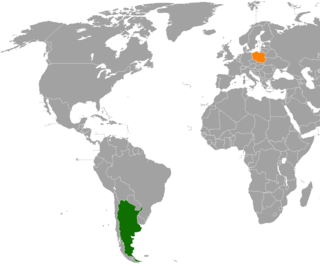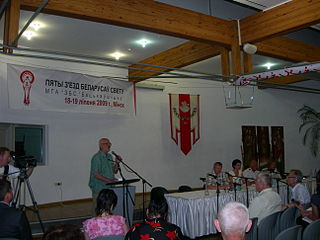Related Research Articles

The German diaspora consists of German people and their descendants who live outside of Germany. The term is used in particular to refer to the aspects of migration of German speakers from Central Europe to different countries around the world. This definition describes the "German" term as a sociolinguistic group as opposed to the national one since the emigrant groups came from different regions with diverse cultural practices and different varieties of German. For instance, the Alsatians and Hessians were often simply called "Germans" once they set foot in their new homelands.

Polish Americans are Americans who either have total or partial Polish ancestry, or are citizens of the Republic of Poland. There are an estimated 8.81 million self-identified Polish Americans, representing about 2.67% of the U.S. population, according to the 2021 American Community Survey conducted by the U.S. Census Bureau.

The Polish diaspora comprises Poles and people of Polish heritage or origin who live outside Poland. The Polish diaspora is also known in modern Polish as Polonia, the name for Poland in Latin and many Romance languages.
This article details the geographical distribution of speakers of the German language, regardless of the legislative status within the countries where it is spoken. In addition to the German-speaking area in Europe, German-speaking minorities are present in many countries and on all six inhabited continents.

Immigration to Argentina began in several millennia BCE with the arrival of different populations from Asia to the Americas through Beringia, according to the most accepted theories, and were slowly populating the Americas. Upon arrival of the Spaniards, the native inhabitants of Argentine territory were approximately 300,000 people belonging to many Indigenous American civilizations, cultures, and tribes.

Polish Brazilians refers to Brazilians of full or partial Polish ancestry who are aware of such ancestry and remain connected, to some degree, to Polish culture, or Polish-born people permanently residing in Brazil. Also, a Polish Brazilian may have one Polish parent.

Diplomatic relations between Argentina and Poland, have existed for over a century. Over 500,000 Argentines are of Polish descent making Argentina the second Latin-American country with the largest Polish community abroad.

Canada–Poland relations are foreign relations between Canada and Poland. Both countries are full members of the Organisation for Economic Co-operation and Development, NATO, the Organization for Security and Co-operation in Europe and the World Trade Organization.
Following centuries of relative ethnic diversity, the population of modern Poland has become nearly completely ethnically homogeneous Polish as a result of the altered borders as well as both the Nazi German and Soviet Russian or Polish Communist campaigns of genocide, expulsion and deportation during and after World War II in the country. Nevertheless, various ethnic minorities of various origin remain in Poland today, including some newly arrived or grown in size in recent decades.

Poland–Uruguay relations are foreign relations between Poland and Uruguay. Neither country has a resident ambassador. Both nations are members of the United Nations.

The Belarusian diaspora refers to emigrants from the territory of Belarus as well as to their descendants.

The demographics of Poland constitute all demographic features of the population of Poland including population density, ethnicity, education level, the health of the populace, economic status, religious affiliations, and other aspects of the population.
Polish Venezuelans are Venezuelan citizens of full or partial Polish ancestry. The Polish colony in Venezuela is well dispersed throughout the country, but most of the Poles and their descendants live in big cities like Caracas, Maracaibo and Valencia.
The history of Poles in the United States dates to the American Colonial era. Poles have lived in present-day United States territories for over 400 years—since 1608. There are 10 million Americans of Polish descent in the U.S. today. Polish Americans have always been the largest group of Slavic origin in the United States.

Immigration to Uruguay began in several millennia BCE with the arrival of different populations from Asia to the Americas through Beringia, according to the most accepted theories, and were slowly populating the Americas. The most recent waves of immigrants started with the arrival of Spaniards in the 16th century, during the colonial period, to what was then known as the Banda Oriental.

The history of the Jews in Paraguay has been characterised by migration of Jewish people, mainly from European countries, to the South American nation, and has resulted in the Jewish Paraguayan community numbering 1,000 today.

Diplomatic relations between Brazil and Poland were first established in 1920. Over 800,000 Brazilians are of Polish descent making Brazil the second country with the largest Polish community abroad. Both nations are members of the United Nations.

Poland–Venezuela relations refers to the bilateral relations between Poland and Venezuela.

Polish Colombians are Colombian citizens of full or partial Polish ancestry, or Polish-born person residing in Colombia. Most of the Polish immigrants that fled from the Holocaust to Colombia were Polish Jews.
White Paraguayans or European Paraguayans are Paraguayan people whose ancestry lies within the continent of Europe, most notably Spain, Italy and Germany, and to a lesser extent, Ukraine and Poland.
References
- ↑ "Ante la crisis, Europa y el mundo miran a Latinoamérica" (in Spanish). Acercando Naciones. 2012. Archived from the original on 2015-05-18.
- 1 2 3 Paragwaj Noclegi. "Polacy w Paragwaju" (in Polish). Retrieved 13 May 2015.
- ↑ Wojciech Tyciński, Krzysztof Sawicki, Departament Współpracy z Polonią MSZ (2009). "Raport o sytuacji Polonii i Polaków za granicą (The official report on the situation of Poles and Polonia abroad)" (PDF). Warsaw: Ministerstwo Spraw Zagranicznych (Ministry of Foreign Affairs of Poland). pp. 1–466. Archived from the original (PDF file, direct download 1.44 MB) on July 21, 2012. Retrieved June 14, 2013.
{{cite web}}: CS1 maint: multiple names: authors list (link) - ↑ Agnieszka Weinar. "Emigration from Poland in the historical perspective". Centre of Migration Research, Warsaw University . Retrieved 16 May 2015.